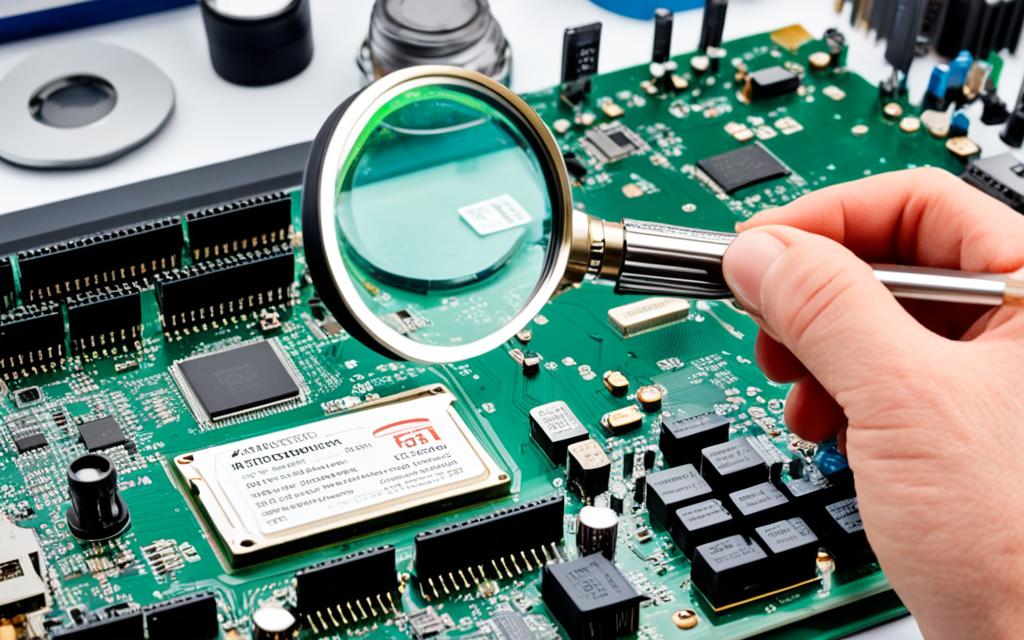How Long Does a Motherboard Last? Lifespan Guide
In this guide, we’ll look into how long a motherboard could last. We’ll check out what makes them work longer. And, we’ll share tips to make your motherboard live its best life. This is handy if you’re building a new computer or thinking of upgrading your current one.
The motherboard is like your computer’s brain. It’s super important for everything to work right. By knowing how long it should last, you can plan when to switch it out. This keeps your computer running well for many years.
Exploring the Average Lifespan of a Motherboard
The motherboard is key to how long a computer lasts. It usually lives for 5 to 7 years. But, this can change based on many things. Knowing about a motherboard’s usual life helps us keep our systems running well. We can also decide when it’s time to get new parts.
Think of the motherboard as the heart of a computer. It makes sure everything works together smoothly. Even though it’s built to be tough, it won’t last forever. How long it lasts can depend on its quality, how you use it, and if you take good care of it.
A motherboard from a top brand can live longer than one that costs less. Quality motherboards are made with stronger parts and ways to keep them cool. These features make them last longer through hard use.
The place where you use your computer matters too. If it’s too hot or dusty, the motherboard can wear out faster. Making sure it’s well-ventilated and clean can make it last longer. This is especially important for its life span.
| Factor | Impact on Motherboard Lifespan |
|---|---|
| Component Quality | High-quality motherboards tend to have a longer average lifespan, typically 5-7 years, compared to budget options. |
| Operating Conditions | Harsh environments with high temperatures, excessive dust, or poor airflow can shorten the typical motherboard lifespan. |
| Maintenance and Care | Regular cleaning, adequate cooling, and avoiding overclocking can help extend the average motherboard life expectancy. |
When we know how long a motherboard usually lasts, we can plan better. We can take steps to keep our computers going strong. And we’ll know when it’s time for something new. This knowledge is key to using our devices for as long as possible.
Key Factors Affecting Motherboard Longevity
The motherboard is the heart of your computer. It’s key for how long your device will work well. Even though it’s made to last, some things can make it wear out faster. Knowing what these are helps keep your computer running smoothly for longer.
Quality of Components
What makes up the motherboard matters a lot. Motherboards with top-notch parts like capacitors and resistors last longer. Choosing a motherboard from a good brand can prevent it from breaking early.
Operating Conditions
Where your motherboard is makes a big difference. High heat, dampness, and dust harm its parts. Making sure your computer stays cool and clean helps it last longer. This also prevents dust and moisture from ruining it.
Knowing about component quality and maintenance helps. It lets us choose and take care of our computer’s main part. With this info, we can make our motherboard last and our computer stay fast over time.
Signs That Your Motherboard Needs Replacement
The motherboard is like a computer’s heart. It connects all the vital hardware. Over time, motherboards reach the end of their life. They show signs when they need to be replaced. Knowing these signs early helps keep our computers running smoothly.
One common sign is the computer crashing often or showing blue screens. These failures can mean the motherboard is not working well.
- Frequent system crashes or blue screens of death (BSoDs)
- Compatibility issues with new hardware or software
- Unexplained performance problems, such as stuttering or freezing
- Inability to boot up the computer or post error messages
Problems with new devices or software can show the motherboard is behind. If performance issues like stuttering happen, the motherboard might be old. These are other signs it could be failing.
You might not be able to turn on the computer or see error messages. This is a strong sign that the motherboard needs to be replaced. Knowing these signs lets us fix the problem early.
Watch your computer’s performance closely. The signs of a failing motherboard can be different. If you see these problems, it’s best to talk to a professional. They can help you decide if it’s time to get a new motherboard. This can prevent more issues and keep your computer healthy.
Maximizing Your Motherboard’s Lifespan
To keep your motherboard alive and well for years, you need to be proactive. This means making sure it stays cool and clean. Proper cooling and airflow are crucial for its longevity. Also, don’t forget about regular care and cleaning, which can make a big difference.
Proper Cooling and Airflow
Your motherboard runs hot when you use it, and too much heat is bad news. It can make your tech unstable or fail earlier than it should. The best defense here is to have good cooling and airflow. Adding case fans or a cooler for your CPU can help. They take the heat away, adding more life to your motherboard.
Regular Maintenance and Cleaning
After cooling, keeping your motherboard clean is also key. Dust and dirt can block the airways around your machine. This can prevent cool air from doing its job. So, it’s a good idea to give your gear a cleaning now and then. A can of air or a soft brush will work. Plus, a clean house for your parts means a longer life for your whole system.

| Cooling Recommendation | Impact on Motherboard Lifespan |
|---|---|
| Efficient Case Fans | Helps draw heat away from the motherboard, preventing heat-related damage |
| Dedicated CPU Cooler | Effectively cools the CPU, which can generate significant heat and impact the motherboard |
| Regular Cleaning and Dust Removal | Maintains optimal airflow and operating conditions, extending the overall lifespan of the motherboard |
By focusing on these cooling and cleaning tips, you can make your motherboard last longer. This ensures your computer runs smoothly for many more years.
How Long Does a Motherboard Last?
The motherboard is very important when we talk about computer parts lasting a long time. It’s like the heart of a computer, connecting all its key parts. This makes it vital for the PC’s overall health and performance. But what’s the typical life of a motherboard?
On average, with good care, a motherboard can last between 5 to 7 years. The real lifespan of a motherboard changes a lot, though. This depends on the quality of its parts, how you use it, and how well you keep it cool and clean.
Factors Affecting Motherboard Longevity
Different things can change how long a motherboard lasts:
- Component Quality: Motherboards made with better parts, like solid capacitors, last longer than those with poorer quality pieces.
- Usage Patterns: Lighter computer use makes motherboards last longer than heavy, daily use.
- Environmental Conditions: A motherboard in a cool, clean space does better than one in hot, dusty areas.
Knowing these factors lets you take steps to keep your motherboard healthy. This can make your computer work well for a long time.
Upgrading vs. Replacing Your Motherboard
As computers age, we might wonder if it’s better to upgrade or replace our motherboard. This choice impacts our PC’s performance and longevity. We’ll see what to think about when choosing between upgrading or replacing it.
When Is Upgrading Worth It?
If you want to use new tech and features, upgrading might be better. You should upgrade if your current motherboard works well but lacks recent advancements. For example, you might need support for faster processors or more memory.
It can also extend your computer’s life without swapping out everything. This is good when your processor, RAM, and storage are up-to-date. Just make sure the new motherboard works with your old parts to avoid any problems.
When to Replace Your Motherboard
However, if your current motherboard is old, not working well, or doesn’t fit your needs, it’s time to replace it. Signs you need a new one include a lot of hardware failures or problems with new devices. Both can show your motherboard can’t handle today’s tech demands.
Choosing a new motherboard is better if you need a big tech leap. For example, needing a new CPU type or more memory. This option offers a complete upgrade, boosting your system’s performance.
Deciding whether to upgrade or replace your motherboard means looking at your PC’s needs. You also need to weigh the costs and benefits of each choice. This way, you can choose what’s best for your computer and wallet.
Choosing the Right Motherboard for Your Needs
Finding the right motherboard is key for your computer building or upgrading journey. The motherboard, often called a mobo, is the backbone of your system. It’s where all parts connect. When selecting a new motherboard, consider a few important points to match your needs perfectly.
Start by checking the CPU socket type. It must fit your chosen processor. The CPU socket type shows which CPUs can work with your motherboard. It’s also important to look at RAM compatibility. Make sure the motherboard can handle the type and speed of RAM you need.
- Identify the CPU socket type to ensure compatibility with your processor
- Check the RAM support, including the type and maximum speed
Next up, look at the motherboard’s expansion slots. If you’ll add parts like a graphics card or a sound card, you need specific slots. Also, check how many SATA ports and USB ports are available. These are crucial for connecting drives and other devices.
- Evaluate the expansion slot options, including PCIe and PCI slots
- Look for the necessary connectivity ports, such as SATA, USB, and Ethernet
Don’t forget about the motherboard features and quality. Check for onboard sound, cooling, and power capabilities. These affect how well your system runs and how long it lasts. With these tips, you can pick a motherboard that fits your needs now and in the future.
Advanced Troubleshooting for Motherboard Issues
Are you having constant troubles with your computer’s motherboard? Maybe you’re dealing with system crashes, boot problems, or parts not working together. Addressing these issues early on can lengthen your computer’s life and save you from buying a new one.
To start solving motherboard problems, check each part like the RAM, CPU, or hard drives. This helps find any faulty or wrong parts that might be causing the issues. Also, updating the BIOS or firmware of the motherboard can fix some compatibility problems and make your system run better.
If trying the motherboard troubleshooting guide doesn’t work, it’s time to get help. A skilled technician can run more detailed tests and suggest what to do next, like fixing or changing the motherboard. With their help, we make sure the real problem is dealt with, stopping more issues from happening.




